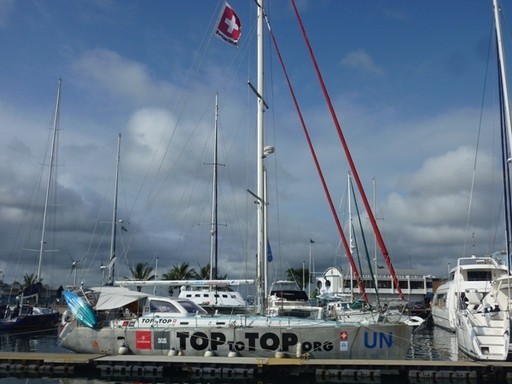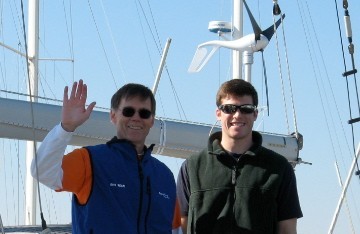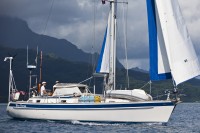Blue Heron
| Vessel Name: | Blue Heron |
| Vessel Make/Model: | Hallberg Rassy 43 |
| Hailing Port: | Delaware City, DE |
| Crew: | Bob & Eric Frantz |
| About: | Bob retired in January, 2011 from a career as an environmental attorney and manager, and Eric earned his Bachelor's Degree from The George Washington University in Washington, DC in December, 2010. They began their circumnavigation February 6, 2011. |
| Extra: | In the words of that great American author, Mark Twain, “Twenty years from now you will be more disappointed by the things that you didn't do than by the ones you did do. So throw off the bowlines. Sail away from the safe harbor. Catch the trade winds in your sails. Explore. Dream. Discover.” |
19 June 2012
The Blue Heron did it!
Today is the 500th day since we began our adventure around the world. We did it! We've completed our circumnavigation! We have not only crossed our wake but have passed the point from which we originally set sail on February 6, 2011. All that remains is to get us and the Blue Heron home. She has [...]
13 June 2012 | Fishing Bay Harbor Marina, Deltaville, VA
Waiting to get back on our way
We passed Little Creek Marina in Norfolk, VA during the middle of the night last night -- that's where our dream voyage began 16 months ago. We then made our way to the mouth of the Chesapeake Bay where we were greeted with a howling hello in the form of 30+ knot winds on the nose. Making any headway was almost impossible so, we have diverted for safe harbor once more to wait for this weather system to pass. If anything, the North Atlantic lives up to it's reputation as being predictably unpredictable. Now, we wait (impatiently) for another weather window so that we can make our way home.
12 June 2012
Big Fish - take a look
Our steady progress and, generally, uneventful passage thusfar was punctuated with excitement yesterday afternoon when Eric called out, "I've got one!" He caught a White Marlin in the late afternoon. The fish fought hard and we had quite a time getting the fish on board. The fish measured 6'4" and [...]
09 June 2012
on our way north
This morning we left West Palm Beach at 8:15AM and are making our way north. We're hopeful that weather will be in our favor the entire final passage home -- we'll see. We've started with the benefit of both the gulf stream and favorable winds and are moving along at about 9 knots.
05 June 2012 | Cannonsport Marina, Palm Beach Shores, Florida
weather detour
We're stopping in Palm Beach for a day or so to wait out some weather due to come offshore from the Carolinas. Then we'll continue our northbound journey for home.
From Pollywogs to Shellbacks
We had a fast passage from Las Perlas Islands in Panama to the Galapagos, making it in 5 days, with 15 to 20 knot trade winds behind us most of the way. On the way, we experienced the Tsunami from the earthquake in Japan, and we crossed the equator. The Tsunami turned out to be nothing, as we were at sea, although we noted some anomalous readings in our depth finder (showing shallower water where it shouldn't be shallow) at the projected time of passage of the Tsunami. Once we got to the Galapagos, we learned that the Tsunami had caused some erosion of beaches due to the surge in water level.
We crossed the equator just before midnight on 3/15. I understand that it is a Navy tradition (Jerry, a Navy veteran, was our expert on this) that until crossing the equator on a ship you are considered a "pollywog" and after doing so, you are considered a "shellback". There is much tradition associated with this, and we considered various means to recognize it, finally settling on a shot of rum (half shot for the person on watch).
We arrived in San Cristobol on 3/16 at 08:30, and called our agent, who assisted with getting our cruising permit (autographo) and with immigration. He told us the government representatives would arrive by 15:30, so we had to wait. 15:30 came and went, and at 16:30 our agent arrived by water taxi to tell us that the government representatives would come the next day at
10:00. The next morning we were boarded by six Ecuadorean government representatives, who proceeded to inspect the boat and ask many questions. After exchanging many documents and many signatures, the representatives left and we were in. We then needed to go with our agent and pay the fees.
Over the next few days, we explored the island. We hiked to the top of a volcano, which was filled with fresh water, making it a smaller version of Crater Lake in Oregon. Frigate birds (the males of which sport bright red bulbs below their heads, which they puff up during mating season) were numerous and our guide told us that they used the lake to wash the salt water from their feathers. We saw tortoises, and visited a tortoise preserve, where we saw them
in all stages of development.
We took a snorkeling tour to Isla Lobos and Kicker Rock, where we swam with turtles, iguanas and sea lions. The sea lions like to play with you in the water, and one came right up to my mask and blew bubbles in my face. Fish of all colors and variety swam around us, and Jerry saw a shark at Kicker Rock.
We left for Isla Isabella on 3/19 and arrived at Puerto Villamil around 08:30 on 3/20 after an easy overnight sail.
The anchorage was a little tricky to enter and our GPS was off by enough to show that we ran aground. Fortunately, we found a spot with plenty of water and dropped anchor.
Penguins and seals swam by curiously as we waited for the port captain. A boat arrived shortly. None of them spoke English, so the visit was brief. We took the dinghy into the local marina and then a taxi to the Port Captain to complete the check in process. The power was out, so we had
to wait and try back later. Unfortunately, we came back to find out that we "were not in the system." It took a total of three days and numerous requests by the port captain for us to "come back later" to finally check in--by which time, we were ready to check out.
We used the waiting time to explore the island both on land and in water over the next few days. Isabella is the biggest of the Galapagos Islands and has six volcanoes. We went on a hike on the 23rd that took us to two of the volcanoes, one of which is the second largest caldera in the world. The ten mile hike was long, but made even longer by the guide who insisted on stopping every fifteen minutes to tell us about a bird or flower.
We pulled up anchor the morning of the 24th for Santa Cruz, where we will provision for the trip to Easter Island and say goodbye to the Galapagos Islands.



